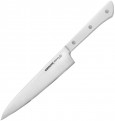Layers number
The number of layers of steel that make up the blade. This parameter is relevant primarily for knives made of Damascus steel (see “Blade material”), however, it can also be indicated for other cases: for example, some knives from traditional Japanese steel grades “shirogami” or “aogami” are made two-layer. However, such models are relatively rare.
As for Damascus, in kitchen knives the number of layers in it can vary from 10 – 13 to 160 – 170. At the same time, there is an opinion that the more layers, the higher the quality of the knife. This is partly true: increasing the "layering" allows you to achieve good strength combined with elasticity, as well as other advanced characteristics. However, note that the actual quality of the blade strongly depends not only on this indicator, but also on many other indicators: the composition of the steels used, the overall quality of processing, technology features, etc. As a result, the number of layers in fact is almost not related to the quality of the blade ; it often happens that in an expensive and advanced model there are fewer layers than in a more affordable analogue. So when choosing, you should first of all focus on the price category of the knife and real reviews about it.
Blade length
The length of a blade is usually measured from the point to the neck (the bulge between the blade and the handle). The value of this parameter is determined primarily by the type of knife. For example, in
models for cleaning, it rarely exceeds 12 cm — otherwise it would be inconvenient to work with small round products). Among
bread, on the contrary, blades shorter than 20 cm are rarely found — loaves of bread can be quite thick, which requires an appropriate knife, etc. However, knives of the same type can also vary significantly in length. In most cases, you can use this principle: a longer knife allows you to work with larger pieces of food, but it is less “agile”, and the length of the blade can affect the price.
Hardness
The hardness of the metal used in the knife blade. Indicated in standard HRC units (according to Rockwell); the higher the value, the harder the blade.
This parameter in knives has a double meaning. On the one hand, the blade must be hard enough so as not to dull prematurely, not form burrs and not deform when bent; on the other hand, it must remain soft in order to sharpen normally, not crack or break (brittleness also increases with increasing hardness). In most kitchen knives, the hardness is in the range of 52 - 62 HRC - it is believed that this range provides the optimal ratio of strength, reliability and ease of sharpening.
In general, ceteris paribus, a knife made of softer steel will have to be sharpened or adjusted more often with musat, however, such procedures themselves will take a little time and effort. Conversely, a hard blade will hold sharpening for a long time, however, you will have to try to restore it.

